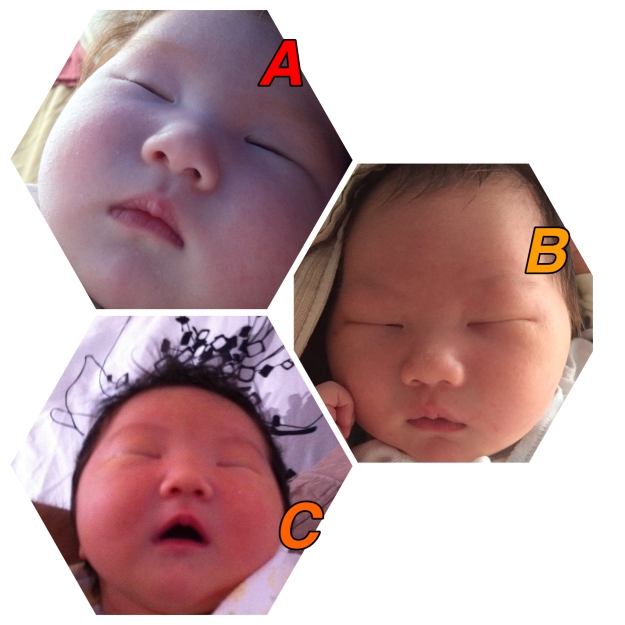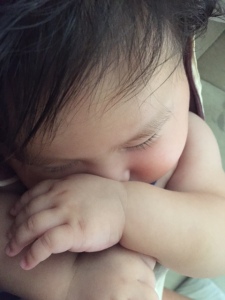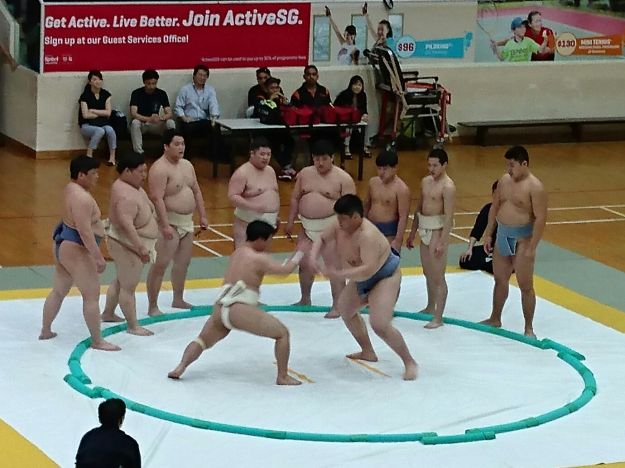
2016 was another big year for us; we welcomed a new member to our brood. Baby boy (LAST baby, this time, really, no, seriously) Luca. We are officially outnumbered. The photo? All the babies at one week old. I’m gonna have trouble explaining which photo belongs to which child later in life….
One of the difficulties of being a multicultural family, speaking several languages and having multiple identities starts before the baby even arrives.
How do we name our kids?
Especially when you have languages, such as Japanese and English, where the naming conventions are completely different. We also live in an English and Chinese speaking country.
At least with the girls, it was a little bit easier. There’s a greater variety of girl names, especially in Japanese, and the rules are fairly flexible. I insisted on a few things when we named our girls.
- They must have Kanji associated with their name
- The Kanji must give meaning to the name
- Anyone should be able to pronounce the name
And the bonus challenge, the Kanji in their name must link to the season they were born in.
Yeah, I made this harder for us than it needed to be. Really.
So here’s the summary of the sisters’ names.
Nina(新菜) – Yes, new and green. In Chinese, new vegetable. Well, I hadn’t accounted for the Chinese use of Kanji. As she was born in January, in the dead of winter, we named her “coming spring”. Nina is also a popular name in Marc’s family (his grandmother and two cousins), so this made perfect sense.
Mila (実良) – 実 is harvest. 良 is good. There. Good harvest. In case there was any confusion, she was born in the fall. We also applied the grander meaning of “harvest” to her name, since, as parents, we wish her to have a fulfilling life.
And here’s the boy. There are not that many boy names that work in both Japanese and English. Honestly, I just couldn’t get into finding boys names. So I left Marc to think about it for a while. He came up with Noah.
Strangely enough, I liked the name Noah in English, but once I said it in Japanese (yes, with a Japanese accent, the only difference) I didn’t like it. Sorry to all the half Japanese Noahs out there. I know there are many of you, but it’s just a personal preference. I tried to apply Kanji to Noah, then got depressed. I prefer to use very simple kanji for names and not make it too complicated, and I couldn’t really find ones that appealed to me.
For some odd reason, “Noah” as a name is a recent import to Japan and has somehow been adopted as a more of a girl’s name. The sound, I suppose, feels more feminine in Japanese.
After struggling with it for a while, we came up with Luca. Another girl name only in Japan. It’s apparently a very anime sounding name as well. In fact, when I google it, a Final Fantasy character pops up. Well, I gotta see beyond that. I needed a name, and I needed it soon.
A more popular version of the English name Luca in the US would be Lucas or Luke. Just so you can make the joke, “Luke, I am your Fatheeeerrrr” “NOOOOOOO!”
….Marc makes the joke anyway.
So it came down to the Kanji. Can we match Kanji to the name? I ended up coming up with what actually fit in with the rest of my brood.
Luca(琉禾)
Neither Kanji is commonly used. 琉 actually doesn’t really stand on it’s own and neither does 禾. So why use it? Here’s the simplified reason. 琉 is the same character as 瑠. They are just variations that developed over time. 瑠璃 is the only historical use of the Kanji, and though there are several theories on what 瑠璃 means, it is linked with lapis lazuri, which is a blue stone. In Japan, it also stands for the September birth stone. Wow, what are the chances?
“Ca” was particularly difficult and nothing really came to me. I actually didn’t know the character 禾 until my mother brought it up. I looked it up and found that it means “rice crop”. The Kanji symbolizes the rice crop, heavy and ready for harvest. OK, another seasonal term. Perfect. So put together, you get “September Harvest/Blessing”. I was sold. I pitched the spiel to Marc. He agreed that it worked, though he did think I let my personal predicament of having gestational diabetes, living the life without my favorite carb (RICE), affect how we named our son.
Marc did seem to like Noah better, but he couldn’t come up with the Kanji. We also pitched the name to the girls (Their favorite was Christopher Robin Sky – from Winnie the Pooh and Sky, which is the name of a kid they play with in the playground) and between Noah and Luca, they preferred Luca.
Sure, right now, at 3 months, he looks more like “Konishiki – the Sumo baby” than “Luca”, but we like it. So there.
2016年9月、最後の子供(今度こそ、多分、絶対最後!)で初めての息子が産まれました。産まれて思ったのは、あら、同じ顔!やはり私の血が濃いようで。子供達皆産まれた時の顔がそっくり。クイズにしてみると、あらやっぱり同じ顔、とか、私の写真じゃないの~、とのツッコミもいただきましたよ。
何はともあれ、これで、我が家は5人家族に。
今回も悩みましたよ、名前。ハーフの子供の名付けには色々あります。
- ファーストネームとミドルネームで日本語と英語(第二か国語)の名前を分ける
- 日本語と英語(第二か国語)両方で発音しやすい名前をつける
- 日本では日本ごの国籍を作り、まったく別の名前を第二か国語の名前でつける
- 言語の事は置いておいて、親が選んだ名前をつける。あまりハーフだから、とこだわらずにつける、という事ですね。
私の知り合いには、1と2が多めだと思います。そして、両親がそれぞれ好きに呼んでたりとかもあり。子供がわけ分からなくなると思う人もいるかもしれませんが、最初からそうだと、結構すんなり受け入れられるのが子供。疑問に思われるまで疑問に思いませんものね。
うちは、2、派で、上の娘二人は、ご存じ新菜(Nina)と実良(Mila)でつけてます。意味は、主に日本語の漢字重視で考えました。二人とも名前に季節に関係ある漢字を使ってます。そして、英語と日本語だけでなく、誰にでも発音出来る名前にしようと決めてます。NinaもMilaも会う人毎に、うちの国でも、ある名前だわ~、と言われました。
後、こだわりは漢字も出来るだけ簡単なものにする事。字画の多いものは見た目、スッキリしないので。マークにも書きにくい漢字は使わない。
新菜は1月に生まれたので、新しい菜(緑)で新春、新しい春、という意味あいで。春を迎える、という意味も込めて。でも、これ、中国語だと、新しい野菜、になっちゃうのだけど。偶然、マークのお父さん側のおばあちゃん、早くに亡くなられているので、お会いしたことはないけれど、もNinaさんだったとか、マークの家族にはNinaさんが数人いるようです。
実良は9月の生まれなので秋の季語で、「良い実り」そして、充実した人生を過ごせるように、という願いを込めて。ちょっと無理やり「良い」をラと、読ませますが、名前では平良、など昔から使われているのでごり押し。Milaという名前も最近増えているようで。日本ではまだあまりない名前のようですが、発音に問題はないので、いいかな、と。
で、3人目は…
これが、浮かばなかったんだな。全然。女の子の名前は色々かわいい名前があって、結構とんとんで決まったのだけど、男の子の名前で、英語と日本語の名前って結構限られていて。どれもしっくりこなくて、結構ぎりぎりまで引っ張ちゃって。しかも途中で、マークに丸投げしたくらいで。
マークなりに考えてはくれたのだけど、男の子の名前に関してだけは、好みがちがうようで、ほぼ全却下。おまけに娘達まで参戦してきて、いや、全然。
例えば、アメリカでは結構人気なNoahが候補に挙がっていたんですが、のあ、って日本語で漢字がなかなかこれだ!!と思えるものがなくて、かたかなやひらがなだと、女の子の名前だし。何より私が、英語でNoahは好きだけど、日本語でのあ、って名前、好きではないな~。と。もともと英語でのNoahは聖書から来てる古~い名前で、日本での「のあ」っていう名前の使い方が新しいのでしょう。同じ名前なのに、英語で言った時と日本語で言った時のイメージが全然違う!と結局私が好きになれず。
すったもんだして、決まったのは、琉禾(Luca)でした。アメリカではLucas、またはLukeの方が圧倒的に多いけど、もとギリシャの方では名前としてあるようで、ヨーロッパでも男の子の名前として使われているようです。日本語ではルーク、もルーカスも名前として無理かな、と。ただ、日本語ではこちらも「るか」で女の子っぽいのですが。
決め手になったのは、漢字でした。琉の字は琉球のイメージが強くて、沖縄とリンクする事が多いのですが、瑠璃の瑠の異体字らしいです。漢字一字では、余り意味を持つ漢字ではないのですが、諸説はありますが日本では、瑠璃はガラス細工の事だったり、ラピスラズリとも言われているらしい、しかもラピスラズリは、9月の誕生石。ぴたっとイメージにはまった!私は昔からラピスラズリが好きで、香港で、新菜と実良のハンコを作った時に私とマーク用にラピスラズリで一本作っているんです。「瑠」よりは「琉」の方が男の子のイメージとしてはあってるかな、と思い、琉に決定。
「禾」、かなり悩みました、結果の果、可能性の可、架、佳、華、どれもしっくりこない~~~~。とイライラしているところに、母から助け舟が。禾の漢字、実は私、恥ずかしながら、知りませんでした。でも、稲の垂れ下がっている図を形にした漢字だと聞いて、「秋」生まれの息子ぴったりじゃん!しかもこの時私は妊娠糖尿病になりかけで、徹底的にお米を避けていて、お米(とか、パンとかパスタ)の事ばっかり考えてたわけで。形もスッキリしていて書きやすい、この漢字しかない!ってなっちゃったのね。
名前全体の意味としては、実良と同じで、荒く考えれば、「禾」は「実り」、という意味でもあるし。「九月の実り」っていうイメージで、私の中でしっくり来たのです。漢字、しかも季語を使える、誰でも発音出来る、ここ大事。マークにも意味を説明すると、「長すぎて、飛躍しすぐな気もしないではないけど、いいんじゃない、書きやすいし」と前向きなお返事が。彼は、最後まで微妙にNoah押しだったのだけど。新菜と実良にも「どっちがいい?Lucaだよね~。」と刷り込んで、賛成してもらいました。
でも、まわりの家族には、アニメネームだ、キラキラだ、読めねー、と結構不評だった琉禾。いいの、広い世界で日本だけだ、Lucaがアニメなのも、キラキラなのも。世界の大部分では、Lucaは男名なんだ。
そして息子、三か月の今、確かに「小錦」の方がしっくり来る顔をしとりますが、大丈夫、新菜もそうだったもん。強くなれ、息子、ご飯いっぱい食べてね。名前が名前だし、多分食いっぱぐれないよ。うん。
 The best thing about having a baby is their healing powers. No wonder how shitty your day is, you can always count on babies to smooth things out.
The best thing about having a baby is their healing powers. No wonder how shitty your day is, you can always count on babies to smooth things out.



















